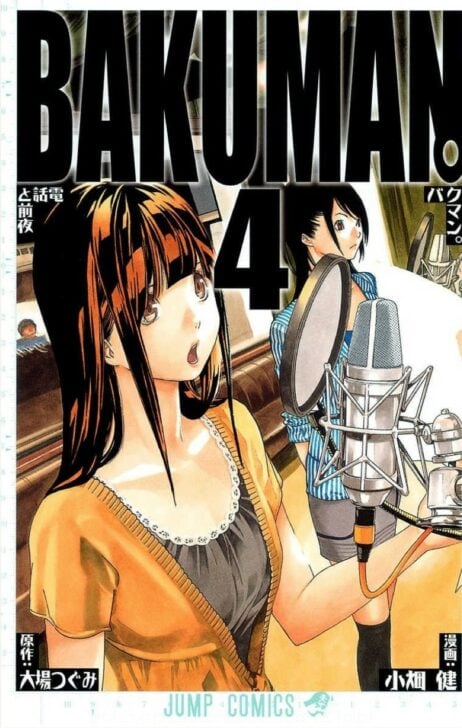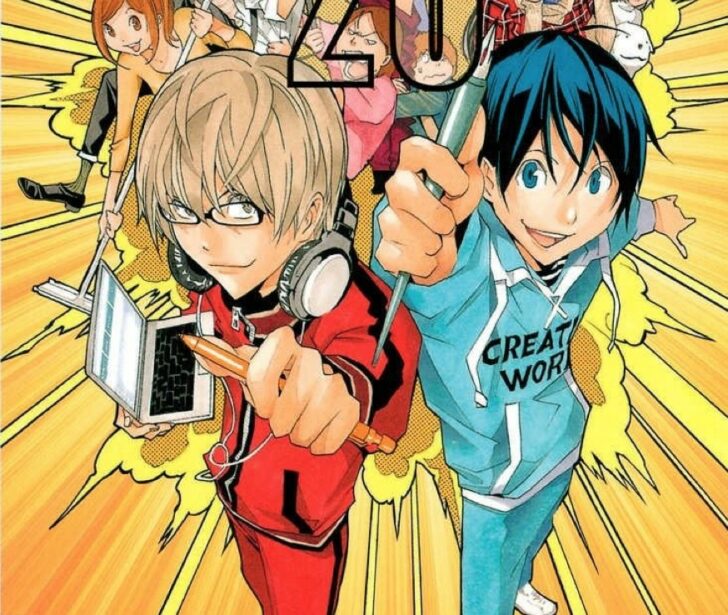Share on your favorite
Or copy the link
Below are navigation links that will take you to the main text and navigation menus.
26,551 first names, 70,620 last names, 333,585 kanji variations.
one of the best Japanese name search tools for your baby!

Image by: Bakuman comic 2 ©Tsugumi Oba, Takeshi Obata/Shueisha Inc
Contents
This manga series is written by Tsugumi Oba and illustrated by Takeshi Obata. This is a story about two high school students Moritaka Mashiro and Akito Takagi aiming to be successful manga writers. Akito had a dream to be a story writer when one day he discovered his classmate Moritaka was so good at drawing pictures. Akito immediately askes Moritaka to be his partner and create manga together. It is a great story that gives you a positive feeling and a touch of the competitive world of manga creating.

Image by: Bakuman comic 1 ©Tsugumi Oba, Takeshi Obata/Shueisha Inc
The title ‘Bakuman’ is both used in the Japanese and English versions and is written in Katakana.

Image by: Bakuman comic 1 ©Tsugumi Oba, Takeshi Obata/Shueisha Inc
In Japanese culture, names have significant meanings that are supposed to represent you as a person. Names can be expressed in hiragana, katakana, and kanji. Let’s find out the meanings of some names of characters in Bakuman.

Image by: Bakuman comic 9 Ep 71 ©Tsugumi Oba, Takeshi Obata/Shueisha Inc
Moritaka, the main character of the series is a talented illustrator and has won several awards for drawing. ‘Ma’(真) means true, ‘Shiro’(城) is a castle, ‘Mori’(最) means the most and ‘Taka’(高) means high. Akito calls him ‘Saikō’(サイコー) because his name ‘Moritaka’(最高) can be read ‘Saikou’ too and it means the best!

Image by: Bakuman comic 2 ©Tsugumi Oba, Takeshi Obata/Shueisha Inc
Akito is a great story writer and also one of the smartest in class. ‘Taka’(高) means high, ‘Gi’(木) also read as ‘Ki’ is a tree, ‘Aki’(秋) means autumn and ‘To’(人) is a person. Moritaka calls him ‘Shūjin’ because of the other sound of the kanji ‘Shu’(秋) and ‘Jin’(人).

Image by: Bakuman comic 4 ©Tsugumi Oba, Takeshi Obata/Shueisha Inc
While Moritaka and Akito are working to become manga writers, Miho aims to be a voice actress. ‘A’(亜) means next, ‘Zuki’(豆) is a bean, ‘Mi’(美) means beauty and ‘Ho’(保) means to maintain.

Image by: Bakuman comic 20 ©Tsugumi Oba, Takeshi Obata/Shueisha Inc
This is Moritaka and Akito’s pen name as a manga creator. The two boys and Miho promised to work hard for their dreams, so combined their surname ‘Azuki’(亜豆), ‘Mashiro’(真城) and ‘Takagi’(高木) to become ‘Ashirogi’(亜城木). ‘Mu’(夢) means dream and ‘To’(叶) means come true.

Image by: Bakuman comic 11 ©Tsugumi Oba, Takeshi Obata/Shueisha Inc
Eiji is a famous manga creator and is called a genius because of his talents in drawing. ‘Nii’(新) means new, ‘Zuma’(妻) means wife. ‘Eiji’(エイジ) is written in Katakana but there are many ways to write this name in kanji. This is quite a common name, here are more ways to write Eiji.

Image by: Bakuman comic 9 ©Tsugumi Oba, Takeshi Obata/Shueisha Inc
Ko is one of the manga creators who works for the manga magazine ‘Weekly Jump’. Kind and gentle Ko is a good friend of Moritaka and Akito who encourage each other to grow as manga creators. ‘Ao’(蒼) means blue, ‘Ki’(樹) is a tree, and ‘Ko’(紅) means red. Her real name is ‘青木 優梨子’ (Aoki Yuriko). ‘Ao’(青) is blue, ‘Ki’(木) means tree, ‘Yu’(優) means kind, ‘Ri’(梨) is a pear and ‘Ko’(子) means child and is a common ending for girls names. As you can see, there are different kanji used for the same sound. They have basically the same meaning but with a slight difference. ‘青’(Ao) means the color blue but the kanji ‘蒼’(Ao) is mainly used to describe blue things such as sky, sea, or even pale. The kanji ‘Ki’ has an interesting difference too. Both 木 and 樹 means tree but ‘樹’ is only used for trees growing from the ground while ‘木’ is used for a tree growing or chopped off.
Here are some useful phrases from Bakuman which will help you along with your Japanese studies!

Image by: Bakuman comic 5 Ep 35 ©Tsugumi Oba, Takeshi Obata/Shueisha Inc
‘Omoshiroi’ means interesting. ‘Yomu’ is to read and ‘__sete Kure’ means let me. So when you combine it becomes ‘Let me read.’

Image by: Bakuman comic 15 Ep 125 ©Tsugumi Oba, Takeshi Obata/Shueisha Inc
The manga industry is competitive. If you are not popular you won’t get a chance to continue the series. ‘Sa’(差) is the difference and ‘Misetsukeru’ means to show off.
Sort by: Most Kanji Variations
Sorts names by how many different kanji spellings they have. In general, names with more variants tend to be more familiar and widespread in Japan (with some exceptions).
Sort by: Most Viewed
Sorts names by page views on this site. Views reflect global traffic (including Japan), so this does not represent popularity among Japanese people only. A high view count does not necessarily mean the name is famous in Japan.
What is Hiragana?
Hiragana is one of the two Japanese syllabaries. Each character represents a sound (mora), not a meaning. It is used for native words, grammatical particles, verb/adjective endings (okurigana), and to show pronunciation above kanji (furigana). It developed from cursive forms of kanji.
What is Katakana?
Katakana is one of the two Japanese syllabaries. Each character represents a sound (mora), not a meaning. It is mainly used to write foreign words and names, loanwords, onomatopoeia, and for emphasis.
What are English Syllables?
A syllable is a unit of pronunciation in English — it’s the beat you hear when you say a word.
Here are a few quick examples:
cat = 1 syllable
ba-by = 2 syllables
beau-ti-ful = 3 syllables
On this site, English Syllables show how a name naturally breaks into sounds when spoken in English. This helps you understand how English speakers naturally say the name and where they pause between sounds.
What are Japanese Morae?
A mora (plural: morae, Japanese: 拍 Haku) is the basic unit of sound in Japanese — think of it as one rhythmic “beat” when speaking.
Here are a few quick examples:
あ (a) = 1 mora
あい (a-i) = 2 morae
きょう (kyo-u) = 2 morae
On this site, Japanese Morae show how many “beats” a name has in Japanese. Most Japanese names have about 2–4 morae, which affects how natural and rhythmic the name sounds to native speakers.
This helps you see how the name fits into the natural rhythm of Japanese speech.
What is English Transcription?
“English transcription” (romanization) is the romanized form of a Japanese name, intended to reproduce its pronunciation as closely as possible. It is also useful for searching names on this site.
Japanese-Style Nicknames
In Japan, nicknames are used to express familiarity and affection. Typical features include:
Shortened forms: Names are often shortened for closeness, e.g., “Yuki” from “Yukiko” or “Taka” from “Takashi”.
Suffixes: Terms like “-chan” (often for girls, also for young children) and “-kun” (often for boys) are used among family and close friends. Among very close adults, “-chan” may still be used. More details
Use & context: Nicknames are informal—common among friends, family, or close colleagues—and are not suitable for formal or professional settings. Their use implies a certain degree of intimacy.
Long vowels: The long vowel mark “chōonpu” (ー) extends the preceding vowel. For example, “あーちゃん” (A-chan) lengthens the “あ” sound.
Households
Sorts surnames by the estimated number of Japanese households that use them. More households generally indicates a more common or well-known surname.
About our last-name data
